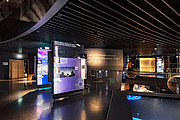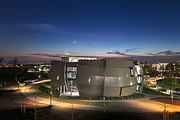Press Release
Free Open Source Materials from the ESO Supernova Planetarium & Visitor Centre
Extensive free materials for astronomy communicators have been made available from the world’s first open-source planetarium
11 January 2019
Since it opened in April 2018, the ESO Supernova Planetarium & Visitor Centre has shared the wonders of the Universe with more than 55 000 visitors and captured the attention of audiences from around the globe. Now, the ESO Supernova’s extensive library of high-resolution images, stunning videos, educational texts and planetarium resources, as well as a digital version of its state-of-the-art astronomical exhibition, have been made freely available online.
The ESO Supernova Planetarium and Visitor Centre is the world’s first open-source planetarium, and part of its mission is to develop and share visuals, texts and materials for both the general public and astronomy science communicators. Now that the ESO Supernova is open to the public, the extensive content of its exhibition, a range of its captivating planetarium shows, and many more high-quality outreach materials are available online for reuse under a Creative Commons 4.0 license. A particular highlight of the ESO Supernova’s open-source material is the permanent exhibition in the ESO Supernova — The Living Universe — which covers the topic of life in the Universe in the broadest sense. It connects visitors with astronomical topics by focusing on the human-Universe connection and how we observe the Universe — with an emphasis on ESO facilities. The text and images of the panels, wall images, floor prints and touch-screens making up this 2200 m2 exhibition are freely available (see summary below).
The panels, designed and laid out by design und mehr, can be enjoyed either on the webpage as HTML-content, as PDF-files, or even as InDesign files, which allow for the panels to be adapted for any required purpose. They answer different astronomical questions on three different levels: very briefly at an infotainment level, more deeply at an educational level, and in an easy way, dedicated to kids. Every panel features high-resolution, stunning images and easy to understand graphics.
Aside from the panels, the new online archive also contains more than 100 kiosk applications, which deliver interactive and non-interactive content on different astronomical topics in depth. Like the panels, these apps are all bilingual. The apps will be updated regularly, in order to add new content and to reflect the latest astronomical research. The apps work on any Internet-enabled computer running a full-screen Chrome browser, but are optimised to be seen on a screen with a format of 16:9 (e.g. 1920×1080 pixels) [1].
Both those interested in astronomy and professionals working in science centres can also browse the extensive database of high-resolution, high-quality astronomical images and videos which were gathered for the ESO Supernova. These archives feature stunning astronomical images collected by telescopes all over the world, educational video-clips, easy to understand graphics explaining astronomical phenomena, artists’ impressions and stunning views of the night sky.
This archive comes in addition to the existing database of images and videos on the ESO main webpage. The videos in ESO’s archive also include 360x180 degree immersive experience movies that can be used with virtual reality (VR) glasses, such as Zeiss VR One, Oculus Rift, HTC Vive or Google Cardboard. A third image and video archive is available on the ESA/Hubble webpage, which is also operated by ESO. All of the material can be reused under Creative Commons 4.0 licenses.
In addition to this range of eye-catching material, ESO also shares a music archive containing almost 500 free music tracks composed by ESO Music Ambassadors, including Jennifer Galatis, Johan B. Monell, tonelabs, John Dyson, STAN DART and Steve Buick. Also available are 3D models of everything from ESO telescopes to orbits of stars within the Milky Way.
ESO has already released stunning visual materials for planetariums, and continues to add to the resources available online. Among the freely available material, two full-length shows can be found: Europe to the Stars and The Sun, Our Living Star. As the Supernova continues to captivate audiences, ESO will continue to develop materials and assets for the public communication of astronomy.
Content summary
|
147 |
|
|
147 |
|
|
104 |
kiosk Apps (working on any PC with a screen and Chrome browser connected to the internet) |
|
18 500 |
High-resolution exhibition images, all under CC (up to 50,000 pixels width) |
|
5000 |
Videos (animations and vodcasts), all under CC (up to UHD resolution) |
|
10 |
|
|
460 |
|
|
13 |
|
|
11 |
Source code repositories for interactive applications developed by HITS |
|
26 |
Webcams, including fish-eye views of Paranal and ALMA to be used in planetariums |
Notes
[1] The apps are released as-is and ESO, unfortunately, cannot deliver any technical support. Note that images and videos will need some minutes to be downloaded the first time the app is started and stores these in the cache. Use the latest Chrome browser and run it in Kiosk mode. (google-chrome --no-first-run --touch-events=enabled --disable-infobars --disable-session-crashed-bubble --disable-tab-switcher --disable-translate --kiosk URL )
Do not use Incognito mode. Allow sufficient disk space. The Apps are only available in English and German.
More information
The ESO Supernova Planetarium & Visitor Centre
The ESO Supernova Planetarium & Visitor Centre is a cutting-edge astronomy centre for the public and an educational facility, located at the site of the ESO Headquarters in Garching bei München. The centre hosts the largest tilted planetarium in Germany, Austria and Switzerland and an interactive exhibition, sharing the fascinating world of astronomy and ESO to inspire coming generations to appreciate and understand the Universe around us. All content is provided in English and German. Our educational programme is free of charge. For more details visit: supernova.eso.org
The ESO Supernova Planetarium & Visitor Centre is a cooperation between the European Southern Observatory (ESO) and the Heidelberg Institute for Theoretical Studies (HITS). The building is a donation from the Klaus Tschira Stiftung (KTS), a German foundation, and ESO runs the facility.
ESO Supernova is proudly supported by LOR Foundation, Evans & Sutherland, Sky-Skan and Energie-Wende-Garching.
KTS
The Klaus Tschira Stiftung (KTS) was created in 1995 by the physicist and SAP co-founder Klaus Tschira (1940-2015). It is one of Europe’s largest privately funded non-profit foundations. The Foundation promotes the advancement of the natural sciences, mathematics, and computer science, and strives to raise appreciation for these fields. The Foundation’s commitment begins in kindergarten and continues in schools, universities, and research facilities. The Foundation champions new methods of scientific knowledge transfer, and supports both development and intelligible presentation of research findings.
HITS
The Heidelberg Institute for Theoretical Studies (HITS gGmbH) was established in 2010 by the physicist and SAP co-founder Klaus Tschira (1940-2015) and the Klaus Tschira Foundation as a private, non-profit research institute. HITS conducts basic research in the natural sciences, mathematics, and computer science, with a focus on the processing, structuring, and analyzing large amounts of data. The research fields range from molecular biology to astrophysics. The shareholders of HITS are the HITS Stiftung, which is a subsidiary of the Klaus Tschira Foundation, Heidelberg University and the Karlsruhe Institute of Technology (KIT). HITS also cooperates with other universities and research institutes and with industrial partners. The base funding of HITS is provided by the HITS Stiftung with funds received from the Klaus Tschira Foundation. The primary external funding agencies are the Federal Ministry of Education and Research (BMBF), the German Research Foundation (DFG), and the European Union.
ESO
ESO is the foremost intergovernmental astronomy organisation in Europe and the world’s most productive ground-based astronomical observatory by far. It has 16 Member States: Austria, Belgium, Czechia, Denmark, France, Finland, Germany, Ireland, Italy, the Netherlands, Poland, Portugal, Spain, Sweden, Switzerland and the United Kingdom, along with the host state of Chile and with Australia as a Strategic Partner. ESO carries out an ambitious programme focused on the design, construction and operation of powerful ground-based observing facilities enabling astronomers to make important scientific discoveries. ESO also plays a leading role in promoting and organising cooperation in astronomical research. ESO operates three unique world-class observing sites in Chile: La Silla, Paranal and Chajnantor. At Paranal, ESO operates the Very Large Telescope and its world-leading Very Large Telescope Interferometer as well as two survey telescopes, VISTA working in the infrared and the visible-light VLT Survey Telescope. ESO is also a major partner in two facilities on Chajnantor, APEX and ALMA, the largest astronomical project in existence. And on Cerro Armazones, close to Paranal, ESO is building the 39-metre Extremely Large Telescope, the ELT, which will become “the world’s biggest eye on the sky”.
Links
Contacts
Mathias Jäger
Public Information Officer
Garching bei München, Germany
Cell: +49 176 6239700
Email: mjaeger@partner.eso.org
Tania Johnston
ESO Supernova Coordinator
Garching bei München, Germany
Tel: +49 89 320 061 30
Cell: +49 170 867 5293
Email: tjohnsto@eso.org
Lars Lindberg Christensen
Head of ESO ePOD
Garching bei München, Germany
Tel: +49 89 3200 6761
Cell: +49 173 3872 621
Email: lars@eso.org
About the Release
| Release No.: | eso1901 |
| Name: | ESO Supernova Planetarium & Visitor Centre |
| Type: | Unspecified : Technology : Observatory : Facility |



